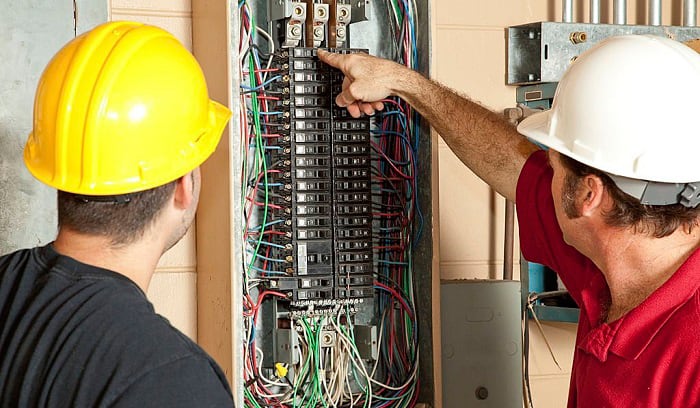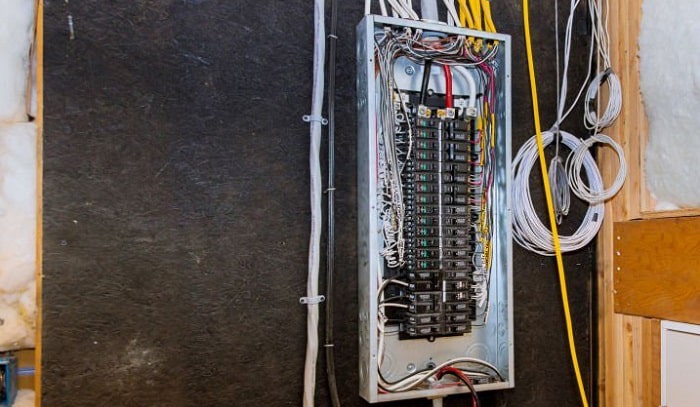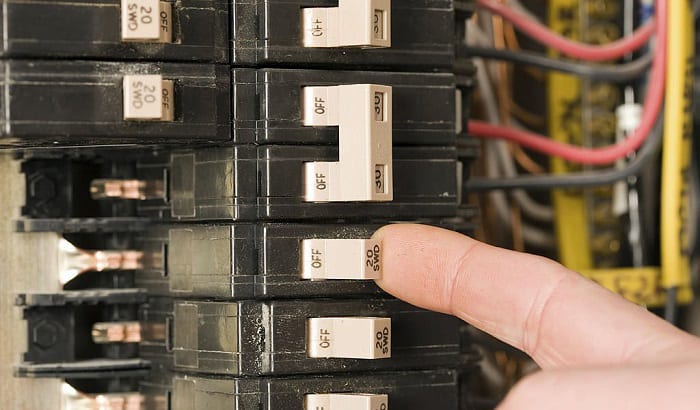How many subpanels can you have on a 200 amp service? There’s no specific limit on the number of sub-panels that a main panel can feed. So, yes, it’s theoretically allowed to let a 200 amp main service supply 1,000 subpanels.
Look instead at the loads that the main panel can handle at any given time, which shouldn’t exceed 200 amps for all rooms.
Continue reading for a more detailed answer and to know more about subpanels. You’ll also learn how to tell if a circuit’s overloaded or a panel has reached its limits and how to calculate loads.
Table of Contents
The Number of Sub Panels You Can Have on a 200 Amp Service
There’s no set number of electrical sub panels you can connect to a 200A main panel. But generally, you’ll see people installing a single 200 amps subpanel (which is rarely done, if ever) or connecting two sub panels with 100 amps each.
You can also have dozens of 100A subpanel feeders, which, in turn, feed another dozen of 100A feeder panels downstream on multiple floors.
You just need to make sure that the loads that are turned on at the same time on the subpanels don’t exceed 200 amps, so as not to cause a trip. The same principle applies to determining how many 100 amp breakers can you put in a 200 amp panel.
Obviously, you’ll need to calculate the total loads of each feeder or breaker and be familiar with your property’s circuit setup. You have to make sure the feeder calculation for the entire property stays under 200 amps.
This limit dips further on a 100 amp service, if you’re ever considering that.
I’ll explain how to do the necessary calculations in the section ‘Determining Subpanel Loads’ below.
What are Some Warning Signs of an Overloaded Electrical Circuit?
The most common symptom would be frequent tripping of the breaker. Once that trip occurs, it will shut down the power on the circuit, so any gadget or appliance connected to it won’t work until you’ve resolved the problem.
Dimming and flickering lights when you switch on appliances are other common signs. Look out for buzzing sounds, the unmistakable smell of electric fires, and blackened and scorched portions on outlets and switches.
If you encounter these issues regularly, it may be time to consider adding a second 200 amp breaker box or a panel with an even higher capacity, especially if you’re planning to expand.
How Can I Check if My Panel is Maxed Out?
If you encounter any of the signs said above and have confirmed that you’re overloading your circuits, it’s logical to also assume that your panels have reached their limit.
Just counting the total circuit breakers on the panel is not enough.
You can start by calling the power company and confirming from them the actual amp rating of your service panel. Once you’ve verified this information, the most recommended step is to use a multimeter to test the amperage of each individual circuit and the service mains coming in.
The amperage of each circuit shouldn’t exceed their breaker’s respective amp ratings.
Once you decide to perform these tests, it’s best practice to go through all your property’s electrical loads (e.g. appliances, lights, other fixtures etc.)
The total amperage figure shouldn’t exceed 80% of the main service’s amp rating. Otherwise, the panel’s basically screaming that it’s maxing out.
Determining Subpanel Loads
You’ll need to be mindful of the following when calculating sub-panel loads:
- The square footage of the area served by the subpanel
- All the types and loads of appliances and gadgets connected to it.
The most convenient way to determine the total load is to use an electrical calculator.
Just specify the panel’s coverage area (in sq. feet), the appliance loads, and their respective voltage amperage.
It’s the closest you can get to a sub panel size calculator because it calculates the total amps you’ll be dealing with. Once you get that figure, you only need to check whether your prospective subpanel will be able to handle the said load based on its rating.
Or Do the Math
If you don’t mind doing the math, you should start by calculating your subpanel’s total coverage with this formula: Total square footage x 3W
Afterward, list and tally the total watts of each circuit that the subpanel will serve. Refer to their respective nameplates to get this information quickly.
You don’t need to include lighting and receptacles since they’re already accounted for in the coverage formula above.
Then, take heed of these formulas:
- If there are more than 4 appliances: Total Watts of Appliances x 0.75 +25% of the largest motor load.
- If there are fewer than 4 appliances: Total Watts of Appliances x 1 + 25% of the largest motor load.
Let’s consider this setup:
- Total square footage coverage = 6,000 watts
- Water heater = 4,500 watts
- Window AC = 1,500 watts
- Dryer = 4,000 watts
- Total Watts of Appliances = 10,000 watts
- 10,000 watts x 1 + 1125 watts = 11,125 watts
We then need to add the watts of the total square footage with the appliance wattage (taking into account the largest motor load) and then multiply the result by 1.25. This adjustment functions as a safety net to account for voltage drop.
- Subpanel Wattage = (11,125 watts + 6,000 watts) x 1.25 = 21,406 watts
Going back to Ohm’s law, we need to divide that sum by 240 volts to find the breaker’s amperage. We’re using 240 volts as a default figure since it’s ubiquitous in service panels in the US.
- 21,406 watts / 240 volts = 89.19 amps
Therefore, the recommended breaker and wire size = 90 amps with 2 AWG copper wire
FAQs
How many amps can you run on a 200 amp service?
200 amps are the maximum limit, but it’s advisable to only run up to 160 amps on such services.
This leads us to another question, “Is 200 amp service enough for most homes?” Currently, it’s adequate for most modern homes. It may be necessary to upgrade to a larger 250A or 300A panel if the property requires heavier-duty HVAC systems, which tend to have the largest loads and require dedicated circuits.
Can you run a 200 amp sub panel off a 200 amp main panel?
Yes, since all panels are rated according to the highest amperage rating that they can handle.
Much like most subpanel feeds, you don’t need to install a dedicated 200A breaker for the subpanel, assuming you’re going to have loads close to this rating since the main breaker on the service panel takes care of the overcurrent protection.
How many 100 amp breakers can I put in a 200 amp panel?
It can be two, two dozen, or more, since a 200A panel can have up to 42 slots. Just make sure not to position the breakers opposite each other with both clipping on the same bus.
If you choose to install multiple 100A CBs, do beware that you’re more likely to load your main service excessively, since putting high-amperage breakers often means you’re trying to cover relatively large loads and feeds or are actively expanding your circuits.
That’s not to mention the varying cost of installing a sub panel.
How large of a subpanel can I install?
While there is no size restriction for a subpanel, you’re only allowed to use the size that’s suitable for your calculated loads, as per Article 220 of the National Electric Code.
What is a subpanel?
It’s any smaller panel that feeds off a property’s service panel or main panel to distribute power. It’s “smaller” in that its breaker slots are often limited to a little over 20.
At best, when most people say they’re adding a second breaker box, they usually mean they’re installing a new subpanel. It could be installed in a detached shed or garage, in the same room as the main panel (e.g. the basement), or in another room in the house.
Related: Sub Panel Installation Cost – Latest Price
Given their shared purpose, the subpanel is built a bit similarly to a main panel, with its own hot bus bars and a slot for a main breaker (unless it’s a “lugs only” subpanel), but with evidently separate neutral and ground bars.
A subpanel doesn’t need a main breaker, as the feeder breaker at the main panel, which it is connected to, takes care of the overcurrent and short circuit protection it requires. Adding a main breaker does provide the perk of being able to shut down power without going to the service panel.
Just like in any panel, you’ll need to match the breaker size and wire size of a subpanel’s wiring run.
The purpose of a subpanel
To give you a good overview of a subpanel’s perks, consider the fact that circuits in a 200 amp panel total 42 slots at most. The problem is that these slots will inevitably fill up over time, even in residential settings because most homes expand.
Subpanels help in more ways than one by delivering these benefits:
- Adding more circuit slots and expanding your property’s electrical system.
- Reducing the load on the main panel.
- Organizing the electrical distribution in your property, especially in terms of the individual loads that each room requires.
- Helping to reduce wiring costs in extensive runs.
How to connect subpanels?
Let’s say you want to add a subpanel to a 200 amp service or feed 2 200 amp panels on a 400 amp service. Once you’ve got your total loads calculated, how should you go about with the “feeding”?
Well, if you look at a standard wiring diagram, you’ll see that it lays out the exact route of the wires from the main panel to the subpanel. Depending on the wiring run, you’ll often have to use conduits and wires that cover the said distance.
Assuming these are already in place, you feed subpanels by terminating (i.e. screwing/torquing) their wires’ ends at the proper bus bars after they’ve been stripped. An average setup involves 2 hot wires, 1 neutral wire, and 1 ground wire.
The connections are fairly straightforward:
- Connect the hot wires (black and red) to the hot bus bar.
- Connect the neutral wire (white) to the neutral bus bar.
- Connect the ground wire (green) to the ground bus bar.
On a 200 amp outdoor sub panel that’s not in the same building as the main panel, Code dictates it needs its own grounding rod, which fulfills a vital protective purpose. Feel free to watch this video to learn more about grounding rods and their importance:
Conclusion
While there is no true limit, the answer to “How many subpanels can you have on a 200 amp service?” is that it depends on your load requirements. Not knowing your exact loads is a tight spot to be in, especially if you’re planning on installing the subpanel(s) yourself.
Don’t have second thoughts about calling your electrician if you find yourself lost when doing your calculations or navigating the NEC.
Related:

I am Edwin Jones, in charge of designing content for Galvinpower. I aspire to use my experiences in marketing to create reliable and necessary information to help our readers. It has been fun to work with Andrew and apply his incredible knowledge to our content.



